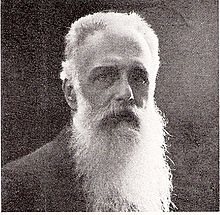Arturo Issel

Arturo Issel (April 11, 1842 – November 27, 1922)[1] was an Italian geologist, palaeontologist, malacologist and archaeologist, born in Genoa.[2] He is noted for first defining the Tyrrhenian Stage in 1914.[3] Issel was also renowned at the time for his work on codifying information within anthropology and ethnology, for which he is still remembered.[4][5]
In 1865, he was searching for the presence of Neanderthal man in Malta. During one of his excursions in Dalam Valley (Wied Dalam), he came across a cave, Għar Dalam, half filled with soil and used as a cattle-pen.[6] Issel thought that an excavation at the site could prove fruitful. He dug a trench in the cave’s loose soil and found prehistoric human remains (from approximately 5000 to 4100 BCE), and a burnt hippopotamus bone.[7][8]
Issel participated in several expeditions to East Africa, including one led by Orazio Antinori and Odoardo Beccari in 1870. He was appointed professor of Geology at the University of Genova in 1866. Issel was a close correspondent with anthropologist Elio Modigliani, and helped promulgate Modigliani's ideas.[4] Issel's son, Raffaele Issel, followed in his footsteps and was appointed professor of zoology at the University of Genova in 1923.[9]
The Issel Bridge, an undersea ridge separating parts of the Tyrrhenian Sea, and the Issel Seamount were named in Arturo Issel's honor.
Bibliography
- Issel A. (1874). Molluschi Borneensi. Genova, Tipografia del R. Instituto Sordo-Muti
- Issel A. (1869). Malacologia del Mar Rosso. Ricerche zoologiche e paleontologiche. Pisa, pp. I-XI, 1-387, Plates I-V
- Giglioli E. H. & Issel A. (1884). Pelagos, saggi sulla vita e sui prodotti del mare. Genova, Tipografia del R. Istituto de' Sordo-Muti
References
- ^ Woodward, Arthur Smith (1923). "Arturo Issel". Quarterly Journal of the Geological Society of London. 79: lvii.
{{cite journal}}: Unknown parameter|subscription=ignored (|url-access=suggested) (help) (Obituary) - ^ Deane, Sidney N. (1924) "Archaeological News" American Journal of Archaeology 28(3): pp. 327-355, p. 329
- ^ Issel, Arturo (1914) "Lembi fossilferi quaternari e recenti nella Sardegna meridionale. Accademia Nazionale dei Lincei 5(23): pp. 759-770
- ^ a b Puccini, Sandra (1988) "Elio Modigliani: Esplorare, osservare, raccogliere nell'esperienza di un etnografo dell'Ottocento" La Ricerca Folklorica No. 18 (subtitled: A sud dell'occidente. Viaggi, missioni e colonie della vecchia Italia) pp. 25-40, pp. 27-28
- ^ Ma le vere e proprie istruzioni per viaggiatori generici, come sappiamo, sono relativamente poche: nel caso italiano sarebbero da citare, in pratica, solo quelle notissime curate da Arturo Issel. (But the real guidelines for generic travellers, as we know, are relatively few: in the case of Italian, it behooves us to cite, practically, only those most famous ones derived from Arturo Issel.) Cerreti, Claudio (1995) "L'istruzione geografica dei viaggiatori" La Ricerca Folklorica No. 32 (subtitled:Alle origini della ricerca sul campo. Questionari, guide e istruzioni di viaggio dal XVIII al XX secolo) pp. 71-78, p. 73
- ^ Fabri, Nadia (2007). Għar Dalam: the Cave, Museum and Garden. Santa Venera, Malta: Heritage Books. p. 11. ISBN 978-99932-7-144-4.
- ^ Fabri 2007, pp. 11–13
- ^ Hancock, Graham. Underworld: The Mysterious Origins of Civilization. New York: Crown Publishers. p. 731. ISBN 978-1-4000-4612-6.
- ^ Cattell, J. McKeen (ed.) (1923) "University and Educational Notes" Science (New Series) 57(1470): p. 267 Stable URL at JSTOR
